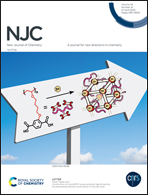Thiazole-substituted non-symmetrical metallophthalocyanines: synthesis, characterization, electrochemical and heavy metal ion sensing properties
Abstract
Non-symmetrical metallophthalocyanines (MPc), in which M is zinc(II), chloromanganese(III), or cobalt(II), containing a thiazole ring in their peripheries were synthesized by the statistical condensation of two different phthalonitriles, namely 4-(4-phenyl-2-thiazolyl)thiophthalonitrile (1) and 4-tert-butylphthalonitrile (2). The newly prepared compounds were characterized via elemental analysis techniques, including ultraviolet-visible spectrophotometry, Fourier transform infrared spectroscopy, proton nuclear magnetic resonance spectroscopy and mass spectrometry. The redox properties of the MPcs were tested via cyclic and square wave voltammetry methods. The redox results elucidated the effects of the metal centers and electrolytic systems on the electrochemical activities of the designed phthalocyanine complexes. The heavy metal ion recognition abilities of these complexes were also analyzed by employing an AT-cut quartz crystal resonator with a fundamental resonance frequency of 10 MHz. The results revealed that Cu2+ at a concentration of 0.40 mg L−1 in the aqueous solution caused a ∼31 kHz frequency shift of the quartz crystal coated with a thin film of MnPc (5). This considerable observed shift in the resonance frequency indicated the powerful sensing ability of compound 5 to detect Cu2+ ions, even in liquid phase. Furthermore, the heavy metal ion sensing results showed that this examined sensitivity of the QCM-based sensor strongly depends upon the atomic radius of the metal ions in aqueous solution.



 Please wait while we load your content...
Please wait while we load your content...